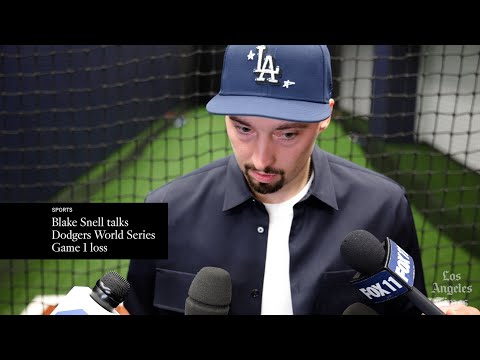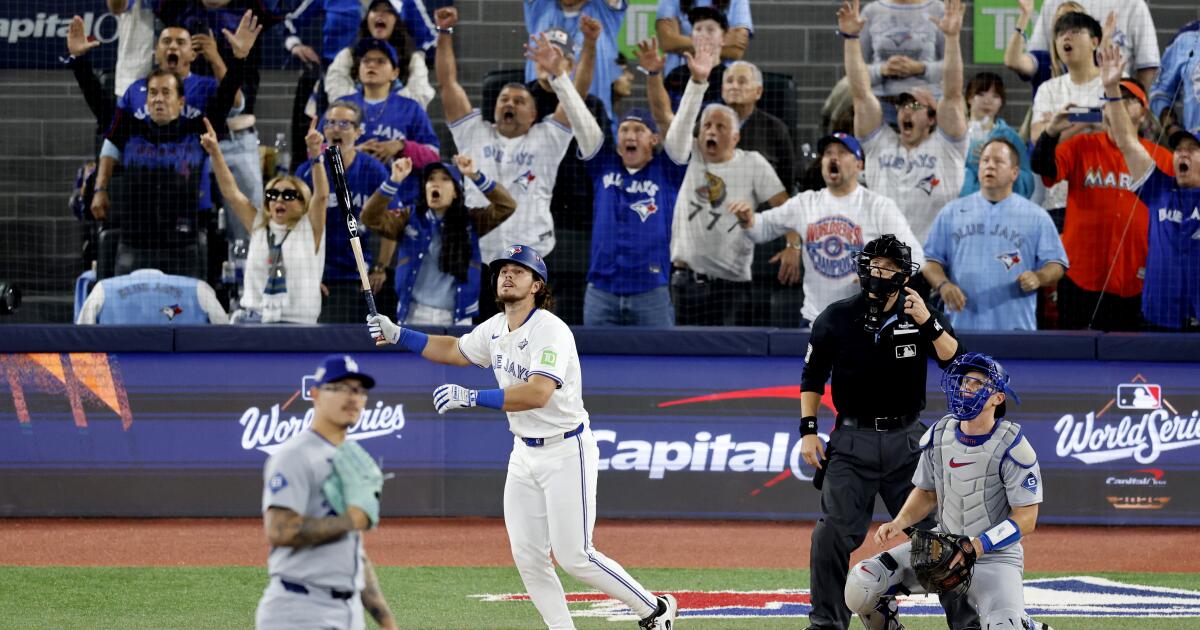TORONTO — The Dodgers might be baseball’s version of an all-powerful Death Star.
But as Friday’s raucous World Series opener in Toronto showed, they too were built with a fatally exploitable weakness.
Behind a nine-run sixth inning that left Rogers Centre rocking and the previously invincible Dodgers rattled, the Blue Jays smashed open what had been a tied score in Game 1 of the World Series and rolled to an eventual 11-4 win.
They attacked the Dodgers’ one glaring weakness in the bullpen. They executed the kind of game script to which the defending champions have long seemed susceptible. And they watched in delight as their visitors were blown to bits, suffering an implosion of galactic proportions in what was the third-highest scoring inning in Fall Classic history.
“Honestly,” Blue Jays outfielder Daulton Varsho said, “we just showed everybody what we can do as a lineup.”

Or, more to the point in this Fall Classic matchup, how they can get to the Dodgers’ rotation-reliant pitching staff.
Even though the Dodgers took an early lead in Game 1, scoring twice in the first three innings against rookie Blue Jays sensation Trey Yesavage, Toronto was methodical in executing its game plan against Dodgers ace Blake Snell.
They kept him under constant stress, starting with a 29-pitch first inning in which they left the bases loaded but drove up his pitch count.
They ensured he wouldn’t go deep into the game, generating more baserunners in each of the next three frames by compounding Snell’s lack of fastball command (which contributed to three walks and left him pitching too often behind in the count) with their own trademark offensive traits of plate discipline (they struck out against him only four times) and contact ability (they whiffed on only 10 of 48 swings against him).
“Blake just didn’t have fastball command. He was working deeper counts,” manager Dave Roberts said. “And when he had count leverage, he really couldn’t put ‘em away, because they were putting the ball in play.”
Eventually, the Blue Jays broke through.
Varsho tied the score in the bottom of the fourth, launching a center-cut, first-pitch fastball to straightaway center for a two-run blast. It was the first home run Snell had allowed all season to a left-handed hitter.
Then, the Blue Jays forced Snell from the game after loading the bases in the bottom of the sixth, knocking him out at the 100-pitch mark before he could even record the first out of the inning.
“Just a tough game,” Snell said.
It also left Roberts in a tight spot — unlike any he’d encountered this postseason.

For much of the month, the Dodgers’ dominant rotation had been able to work out of similar late-inning jams. And the times they couldn’t, Roberts would turn to left-hander Alex Vesia to be his primary fireman.
This series, though, the Dodgers are without Vesia — having left him off the roster while he and his wife deal with what the team described as a “deeply personal family matter.”
And in his absence, a relief corps that was already the weak link on this year’s team has become that much tougher to try to manage around.
“We have a lot of viable options,” Roberts said before the game. “Guys are going to have to step up.”
On Friday, they didn’t.
Roberts first turned to Emmet Sheehan, the converted starting pitcher who did not appear in the team’s NL Championship Series sweep. But he was ineffective, giving up an RBI single to Ernie Clement, a run-scoring walk to Nathan Lukes in what started as an 0-2 count, then another RBI single to Andrés Giménez.
“They made some really good swings, and then obviously the walk can’t happen,” said Sheehan, who left the mound with a 5-2 deficit and only one out recorded. “It’s not a good feeling.”
Roberts’ next decision didn’t work out any better, inserting left-hander Anthony Banda to face left-handed pinch-hitter Addison Barger.
Dodgers reliever Anthony Banda reacts after giving up a grand slam to Toronto’s Addison Barger in the sixth inning in Game 1 of the World Series.
(Robert Gauthier / Los Angeles Times)
Four pitches in, Banda hung a slider. With the first pinch-hit grand slam in World Series history, Barger detonated the Dodgers’ reactor core.
“Bad pitch,” Banda said. “He took advantage.”
The damage would only keep coming from there, with Kirk adding a two-run blast later to make it a nine-run inning.
“We just didn’t make pitches when we needed to to keep that game close,” Roberts said.
And now the question is whether the Dodgers will be able to cover the rest of this series.
“Tonight,” Banda conceded, “was just very bad.”
The bullpen, of course, isn’t the sole reason the Dodgers find themselves facing a 1-0 World Series deficit.
Toronto’s Addison Barger, center, celebrates with teammates after hitting a grand slam in the sixth inning of Game 1 of the World Series on Friday night.
(Gina Ferazzi / Los Angeles Times)
The team’s lineup squandered several early chances — including leaving the bases loaded in the second — that could’ve opened up a more comfortable lead against Yesavage, who managed only four innings.
And once the Dodgers did get into Toronto’s bullpen — which actually entered this series with a worse postseason ERA than even the Dodgers’ shaky group — their offense went silent, generating just one baserunner in their two trips to the plate when the game was tied in the fifth and sixth.
Their only late scoring came on a garbage-time homer from Shohei Ohtani, who was later serenaded with chants of “We don’t need you!” from a Blue Jays fan base that had hoped he’d sign in Toronto as a free agent two years ago.
Still, the Dodgers’ bullpen always figured to loom larger in this series than it had previously in these playoffs. Toronto’s lineup is the deepest, and most balanced, they’ve faced so far this October. It was better equipped than the top-heavy Phillies or light-hitting Brewers to get the Dodgers’ starters out of the game earlier, and force their relievers into high-leverage spots.
Add in Vesia’s absence, and the club’s reliance on Sheehan (a second-year big-leaguer pitching exclusively out of the bullpen for the first time), Banda (who is now the top left-hander by default, following an up-and-down campaign) and veteran Blake Treinen (who has been better in the playoffs, but is still coming off a career-worst performance in the regular season) to serve as a bridge to closer Roki Sasaki has suddenly become heightened.
Friday brought an immediate first test — and a failure of horrifically spectacular fashion.
“They need to bounce back,” Roberts said. “I wouldn’t say concerning. … But, yeah, with the construct of the pen, we’re going to need ‘em.”
Otherwise, the team’s one fatal flaw might continue to be exposed.
One game into this World Series, their most vulnerable weak spot has already been exploited.
“We got a long way to go, a lot of baseball [left],” Roberts said. “But they certainly got to make good pitches.”

Highlights from the Dodgers’ 11-4 loss to the Toronto Blue Jays in Game 1 of the World Series.
